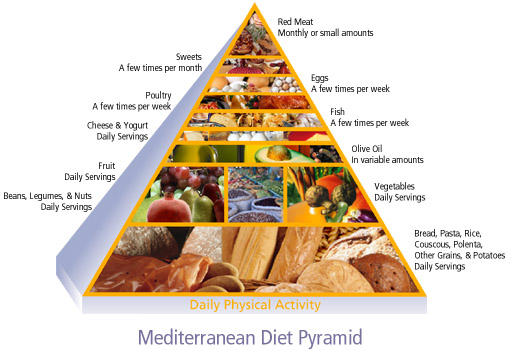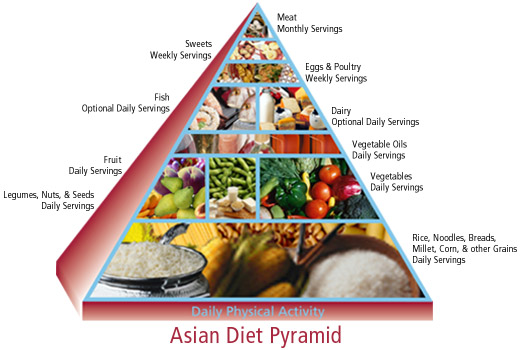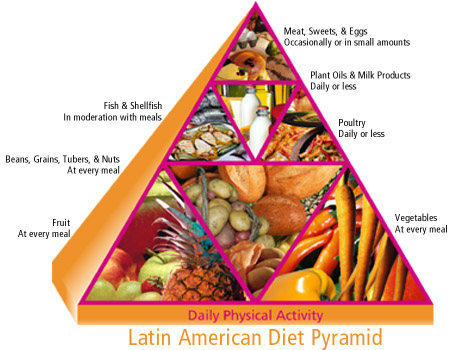health guides
Food Groups and the Food Pyramid

The Food Pyramid
The Food Pyramid is a visual image illustrating the contributions of each group of foods that make up a healthy diet.
The US Department of Agriculture (USDA) created the first Food Pyramid, which placed foods recommended for frequent consumption at the base and foods that should be eaten sparingly at the top. Other pyramids emphasizing ethnic and other food preferences have been developed following this design. The most recent update of the USDA pyramid changes this basic design by dividing it into vertical wedges of different widths to represent the different food groups. This update also represents a shift in thinking in American nutrition. Greater emphasis is placed on weight control and exercise, whole grains are recommended over processed grain products, and rather than recommending a diet low in all fats, emphasis is placed on avoiding solid fats (those that are high in trans fats and saturated fats) while allowing foods that are good sources of monosaturated fats and essential fatty acids.
The new USDA Food Pyramid is meant to be used in conjunction with the Web site (mypyramid.gov), where information about a person's age, gender, and physical activity level is used to calculate a personal recommendation for the amount of each food group to be eaten daily. The Web site also offers tips for following these recommendations, diet and exercise tracking tools, and additional information.
The basic pyramid, developed by the USDA and the US Department of Health and Human Services, is only one model, however. This pyramid has been adapted for ethnic preferences and there are now pyramids for the Mediterranean diet, the Asian diet, and the Latin American diet. Other diets, such as the vegetarian diet, can also be placed on a food pyramid.
Goals of the USDA Pyramid:
The personal recommendations available from the USDA Web site suggest that people:
- Balance calorie intake from foods and drinks with calories expended.
- Engage in regular physical activity and reduce sedentary activities.
- Eat amounts of the following food groups based on daily calorie requirements:
Milk and other calcium-rich products
Meat, poultry, fish, dry beans, eggs, and nuts
Extra calories from added fats, sugars, and alcohol
- Make at least half of the total grains eaten whole grains.
- Eat more dark-green vegetables, orange vegetables, and dry beans and peas. Do not exceed recommended amounts of starchy vegetables.
- Keep the amounts of fruit juice consumed to less than half of total fruit intake.
- Consume 3 portions of fat-free or low-fat (1%) milk, or an equivalent amount of yoghurt, cheese, or other calcium-rich foods per day.
- Make choices that are low-fat or lean when selecting meats and poultry. Consider fish, nuts, and seeds rich in essential fatty acids as alternatives to meat and poultry. Consider dry beans and peas as an alternative to meat or poultry as well as a vegetable choice.
- Choose most fats from sources of monounsaturated and polyunsaturated fatty acids, such as fish, nuts, seeds, and vegetable oils. Choose fat-free, low-fat, or lean meat, poultry, dry beans, milk, and milk products. Choose grain products and prepared foods that are low in saturated fats and trans fats. Limit the amount of solid fats.
- Choose and prepare foods and drinks with little added sugars or caloric sweeteners.
- Choose and prepare foods with little salt. Keep sodium intake less than 2,300 mg per day. At the same time, consume potassium-rich foods, such as fruits and vegetables.
- If one chooses to drink alcohol, consume it in moderation. Some people, or people in certain situations, should not drink.
Variations on the US Food Pyramid:
Some variations on the USDA Food Pyramids represent alternative views of healthy eating by expert groups. For example, the Healthy Eating Pyramid was designed by nutrition experts from the Harvard School of Public Health who felt the USDA Pyramid does not fully reflect all of the research evidence on healthy food choices. This pyramid rests on a foundation of daily exercise and weight control, with emphasis on whole grain foods, plant oils, fruits, vegetables, and some nuts and pulses.
Some food pyramids reflect personal preferences, such as vegetarianism. The Oldways Preservation & Exchange Trust has designed the Traditional Healthy Vegetarian Diet pyramid to represent eating patterns found in healthy populations of the world. This diet emphasises whole grains, fruits, vegetables, and pulses and beans form the basis for each meal, with some milk and egg products. The recommendations are appropriate for most healthy adults, but the guidance of a knowledgeable healthcare professional should be sought to make adjustments for children, women in their reproductive years, and anyone else who may have special nutritional needs.
Other pyramid variations are based on diets from regions with historically lower chronic disease rates, such as the Mediterranean, Asian, and Latin American pyramids shown here. They may be worth considering if your family has a history of heart disease, cancer, high blood pressure, or diabetes.
The Mediterranean Pyramid

The Mediterranean diet begins with the same basis of lots of grains, fresh fruits, and vegetables. Major differences from the USDA pyramid include:
- Using olive oil as the primary fat
- Allowing for only moderate amounts of milk products
- Using fish and poultry, rather than red meat, as the main source of high protein food from animals
- Including wine with meals
The Asian Pyramid

Major differences from the USDA pyramid include:
- Featuring rice and noodles as part of the grain group
- Putting fish and shellfish and dairy in the same section of the pyramid
- Avoiding milk. Most Asians lack sufficient amounts of lactase, the enzyme required to digest lactose.
The Latin American Pyramid

The Latin diet features tortillas, beans, and rice in the grains section.
What counts as a serving?
At first, figuring out what counts as a serving may seem a little tricky. Some servings are close to what people would typically consume at a meal; others are much smaller. For instance, a single serving of rice is only one-half cup whereas people are more likely to consume a cup. A hamburger bun is two to three servings (depending on size). This is not a problem as long as you factor this in before you plan your day’s servings. It is more important for people who are trying to keep a level blood sugar, which is achieved by distributing carbohydrates evenly throughout the day.
When calculating your servings of each food group, be sure to focus on the labels of packaged foods. They contain a great deal of valuable information. To learn more about food labels and how to read them, go to the section on Food Labels.
Food Groups and their typical servings:
The USDA recommends daily amounts according to calorie requirements for each of the food groups in the pyramid.
Grain Group
The USDA recommends 3 to 10 standardised units—“ounce equivalents”—from this group, at least half of which should come from whole grain products such as brown rice, whole grain bread, pasta, and cereals.
Typical ounce equivalents are:
- One slice of bread (1 ounce)
- 1/2 bagel (small)
- 1 ounce of cereal flakes
- 1/2 cup cooked grain, rice, or pasta
- 5 to 6 small biscuits
Vegetable Group
The USDA recommends 1 to 4 portions from this group. Vegetable subgroups that should also be included one or more times per week are dark-green vegetables, orange vegetables, and pulses (beans).
Typical cup equivalents of vegetables are:
- 2 portions raw leafy vegetables
- 1/2 cup cooked or raw non-leafy vegetables
- 1/4 cup vegetable juice
Fruit Group
The USDA recommends 1 to 2 1/2 portions from this group. Juice should be used for less than half of the total fruit intake to ensure adequate fibre is eaten.
Typical cup equivalents of fruit are:
- 1 large orange, peach, or banana; 1 medium pear; 1 small apple
- 1/2 cup chopped fresh, cooked or tinned fruit
- 1 1/2 cup dried fruit
- 1 cup 100% fruit juice
Milk Group
The USDA recommends 2 to 3 portions from this group. Most milk group choices should be fat-free or low fat. Milk products having little or no calcium content (butter, cream, cream cheese) are not part of this group. Those who avoid milk should be sure to eat other calcium-rich foods, such as calcium-fortified drinks, some beans, and some leafy greens.
Typical milk servings are:
Meat and Beans Group
The USDA recommends 2 to 7 ounce equivalents per day from this group. The group includes meat, poultry, fish, dried beans and peas, eggs, nuts, and seeds. Meat and poultry choices should be low in fat. Fish, nuts, and seeds contain more healthy oils and fats than meat, and can frequently be chosen instead of meat or poultry.
Typical meat ounce equivalents are:
- 1 ounce lean meat, poultry, or fish
- 1/2 ounce nuts
- 1 tablespoon nut butter
- 1/2 cup cooked dried beans
- 1 egg
Oils
The USDA recommends 3 to 11 teaspoons per day from this group, which includes fats from fish and plant-based oils that are liquid at room temperature, such as canola, corn, olive, soyabean, and sunflower oils. Foods that are naturally high in oils (nuts, olives, avocados), as well as foods that are mainly oil (mayonnaise, certain salad dressings, trans-fat-free soft margarine), may be used to meet these recommendations.
Teaspoons of oil in typical amounts of foods include:
- 3 teaspoons in 1 tablespoon vegetable oil
- 2 ½ teaspoons in 1 tablespoon mayonnaise or soft margarine
- 2 teaspoons in 2 tablespoons Italian salad dressing
- 1/2 teaspoon in 4 large olives
- 3 teaspoons in 1/2 medium avocado
- 4 teaspoons in 2 tablespoons peanut butter
- 3 teaspoons in 1 ounce most nuts and seeds
Discretionary Calories
Depending on your daily calorie requirements between 165 to 648 additional calories are allowed after satisfying the above food group requirements. These additional calories can be consumed in a few ways:
- Eating more foods from the above food groups
- Eating higher calorie foods from the above food groups
- Adding fats or sweeteners to foods or drinks
- Eating foods providing most of their calories from alcohol, added sugars, or fats (examples include alcoholic drinks, fizzy drinks, and candy)
Exercise Recommendations:
The USDA recommends physical activity, such as walking, gardening, briskly pushing a baby stroller, climbing the stairs, playing football, or dancing. For health benefits, physical activity should be moderate or vigourous and add up to at least 30 minutes a day. Activities should only count toward your overall activity level when they increase the heart rate.
Moderate physical activities include:
- Walking briskly (about 3 1/2 miles per hour)
- Walking
- Gardening/yard work
- Dancing
- Golf (walking and carrying clubs)
- Bicycling (less than 10 miles per hour)
- Weight training (general light workout)
Vigourous physical activities include:
- Running/jogging (5 miles per hour)
- Bicycling (more than 10 miles per hour)
- Swimming (freestyle laps)
- Aerobics classes
- Walking very fast (4 1/2 miles per hour)
- Heavy yard work, such as chopping wood
- Weight lifting (vigourous effort)
- Basketball (competitive)
MyPyramid.gov. www.mypyramid.gov (Accessed May 11, 2005.)
Dietary Guidelines for Americans 2005. www.healthierus.gov/dietaryguidelines (Accessed May 11, 2005.)
Harvard School of Public Health.www.hsph.harvard.edu/nutritionsource/pyramids.html (Accessed June 15, 2005.)
Oldways Preservation & Exchange Trust. www.oldwayspt.org. (Accessed June 15, 2005.)
Copyright © 2024 TraceGains, Inc. All rights reserved.
Learn more about TraceGains, the company.
Information expires December 2024.


 We are proud to announce that
We are proud to announce that  As the market evolves, customers increasingly request a wider variety of omega-3 options for their lipid...
As the market evolves, customers increasingly request a wider variety of omega-3 options for their lipid...  Maintaining healthy glucose levels is crucial for preventing metabolic conditions like diabetes,...
Maintaining healthy glucose levels is crucial for preventing metabolic conditions like diabetes,...  Looking at formulating a new vitamin blend? Discover
Looking at formulating a new vitamin blend? Discover 







































